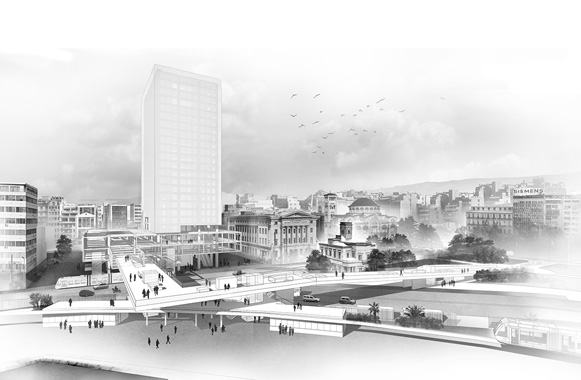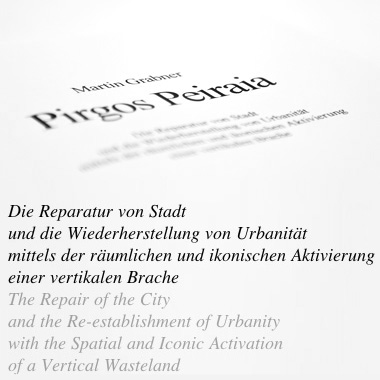
|

|

|
„Die Architektur
gewinnt ihre poetische Dimension
nicht aus einer autonomen Ästhetik,
die frei entwickelt ist,
sondern aus einer Inszenierung
des Ortes selbst, aus dem Vertrauen
in die Schönheit und die Tiefe des
Wirklichen.“
Roger Diener
„Architecture
attains its poetic dimension
not from autonomous aesthetics,
that is freely developed,
but from the of place itself,
from the faith in the beauty
and deepness of the real.“
Roger Diener
|
Pirgos Peiraia
In the middle of the hectic – almost chaotic – heterogeneous space of the port of the Greek town Piraeus reposes a sleeping giant: the Pirgos Peiraia (Piraeus
Tower). With its height of 85 meter the high-rise rises from the not even half as high city like an alien. It is empty, unused since its construction in the 1970ies
and existent only as an image in the perception of the city. A vertical wasteland, used only as supporting structure for large-scale commercial messages.
The present thesis takes this concrete situation as a starting point for an analysis of the relation between high-rise and city, of the (in the most cases unex-
ploited) possibilities of the integration in its neighborhood and the potential to generate a considerable surplus for the city. The Pirgos Peiraia is conceived
as a tool, an instrument of urban development or, generally speaking, the high-rise as an urban project.
The eight essays of the first, theoretical part of the thesis and the photographic essay „Perfected Imperfection“ placed in front have to be understood as a
discussion on the city of Athens and its architecture, on the high-rise, on image and space that goes far beyond a pragmatic analysis only preparing for the
design. It could as well stand on ist own. The rather undefined, contradictory character of the contemporary Athens (and its little sister Piraeus) is highlighted,
the attempts of controlled urbanism and their failure, the Polykatoikia typology as the ubiquitous generic element of the Greek city and the excessive spread
of Athens as a seemingly homogeneous concrete carpet. Moreover the high-rise in its immanent conflict between structural-constructive building and the
creation of symbols and icons is examined and finally the role of architecture as an image (or sign) and as carrier of images (or signs) in the city is
considered.
The second part condenses the acquired in a design that responds very closely to the context of the place – its structure, function and meaning – and formali-
zes the architectural and social attitude. Space and image, interaction and iconicity, close and far are identified as the horizontal and the vertical dimension
of a high-rise in context which constitute a dialectic pair. The tower is completed with its horizontal counterpart, the Ypsilos Dromos. This elevated pathway
connects the building with its surrounding and even more the various spaces among each other. Harbour and city are interlaced again, the existing urban
fabric and the fragmented squares are made tangible as an ensemble, turned present and usable as public space. The new (and re-)created space redeems what
the dominantly towering sign of the Pirgos Peiraia promised for 40 years: a center of urban life. The tower itself houses as inversion of the principle of
„White Cube“ plenty of space fort he production and communication of arts and several ¬culture-affine functions. The immanent iconic power of a high
building is concretized as a White Void, as antithesis to the white noise of the urban flood of images. A simple form that does not need to immediately ex-
press the complexity it internalizes (Ullrich Schwarz), an architecture thats poetry does not arise from its autonomous aesthetics but from the faith in the
place and the staging of it (Roger Diener). A sign against the (self-involved) signs is set. It isn’t produced an architectural spectacle but established an
architecture that offers an urban stage for the social spectacle.
ganzkurzfassung herunterladen (at) / download short abstract (en)
|

|
„Es kommt darauf an,
eine Architektur zu schaffen,
die ein hohes Maß an Komplexität in sich aufnehmen kann,
ohne diese Komplexität gleich wieder gestalterisch umsetzen
und ‚darstellen‘ zu müssen.
Sie darf keine Vollkommenheit simulieren, keine Endgültigkeit fixieren.
Sie muss den Unvollkommenheiten, Unfertigkeiten, Ungereimtheiten
und Dissonanzen des tatsächlichen Lebens Raum bieten.“
Ullrich Schwarz
„It is essential to create an architecture,
that can contain a high degree of complexity
without the necessity to turn it into artistic design
and demonstrate this complexity in the very next moment.
It must not simulate perfection nor determine definitiveness
It has to offer space for the inconsistencies and
dissonances of every-day live.“
Ullrich Schwarz
|
|



